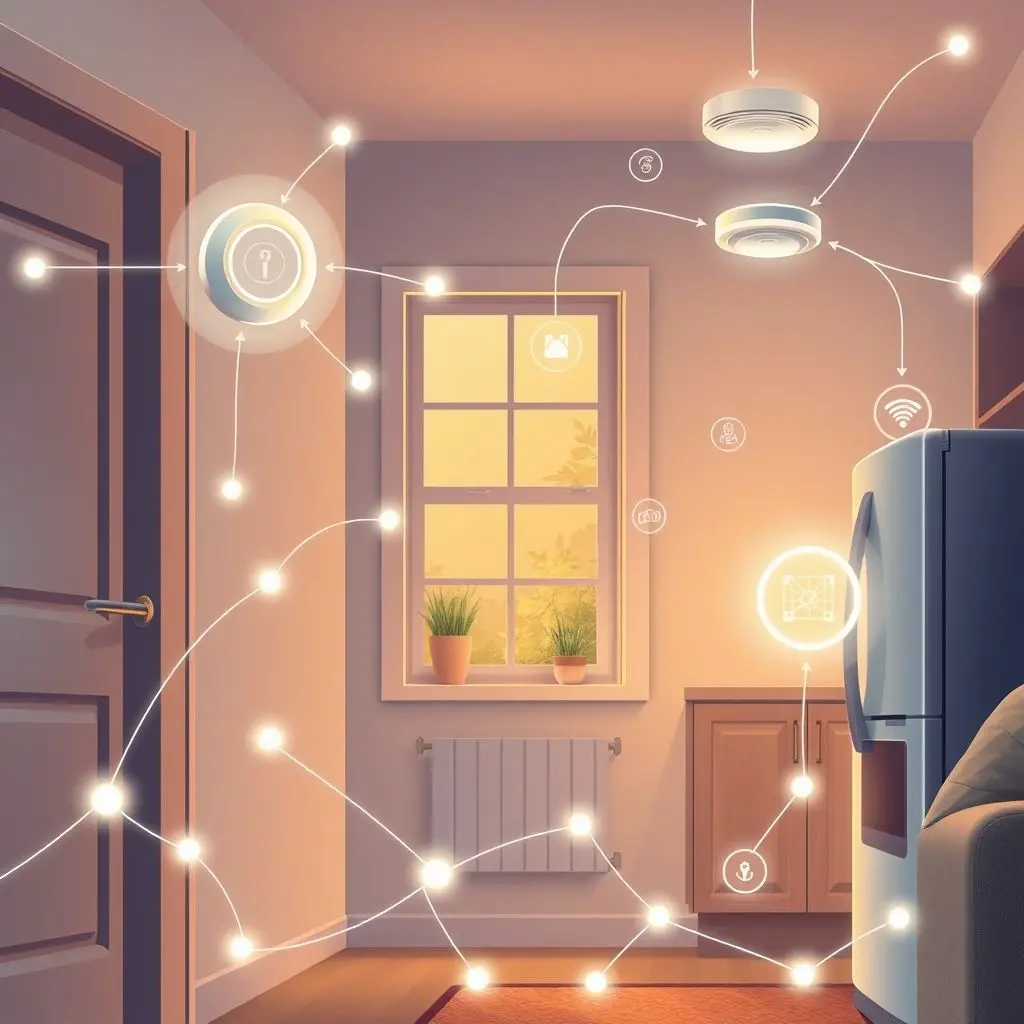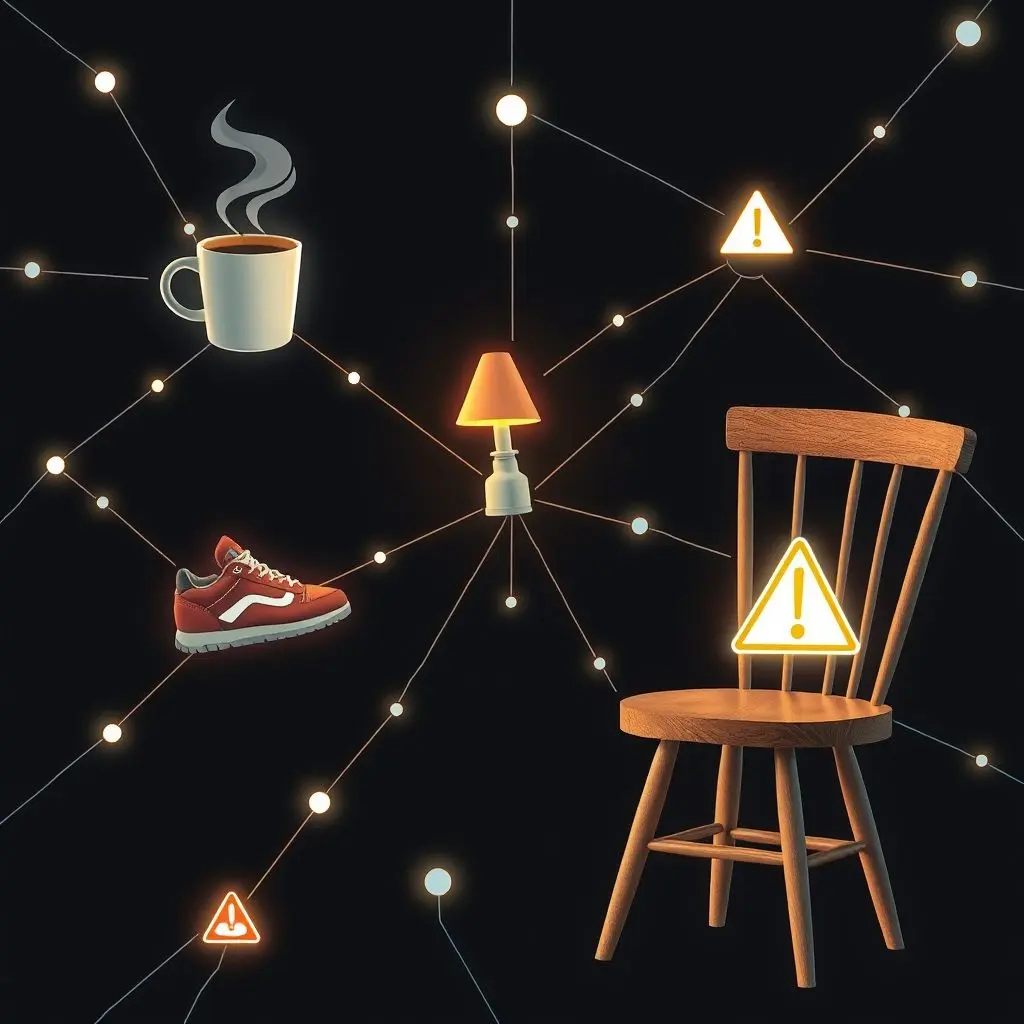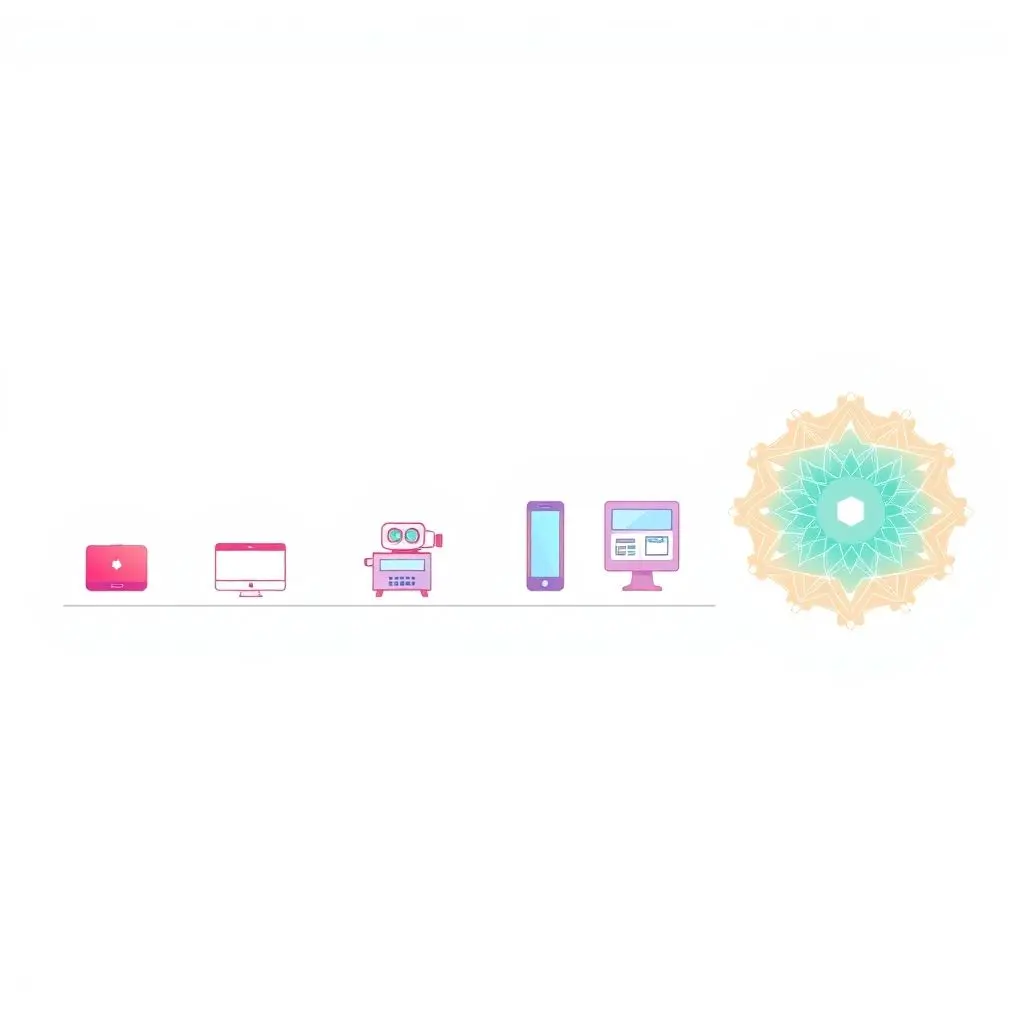Ever pause amidst the morning scramble or the evening wind-down and just… look around? At the mug warming your hands, the shoes waiting by the door, the very paint on the walls? They’re silent observers, steadfast parts of our daily routine. But have you ever let your mind wander to a place where they aren’t silent? Where your coffee cup knows your preferred temperature and brewing time, your sneakers offer advice on your gait, and the walls adjust their hue based on your mood?
It sounds like something straight out of a far-fetched science fiction novel, doesn’t it? A world where not just our phones or smart speakers, but everything possesses its own form of artificial intelligence, capable of sensing, processing, communicating, and even anticipating our needs. This isn’t just about objects doing one specific task; it’s about them having an integrated, perhaps even ‘aware,’ presence in our environment.
If this notion sparks a flicker of curiosity, a sense of wonder, or even a healthy dose of apprehension, you’re not alone. It’s a fascinating concept that prompts us to entirely reimagine our relationship with the inanimate world. We recently put together a brief thought experiment exploring this very idea. Take a moment to watch this:
As the video hints, envisioning a reality where every object holds a spark of digital intelligence pushes the boundaries of our current understanding of technology and connectivity. It’s a concept wrapped in both incredible promise and complex challenges.
Table of Contents
Diving Deeper: What ‘AI in Everything’ Truly Implies
When we talk about AI in a singular object, we typically mean it has a specific capability – perhaps a thermostat learning your heating habits or a vacuum cleaner mapping your home. Now, amplify that. Imagine a future where every manufactured item, from the pen on your desk to the brick in your wall, contains embedded sensors, processing units, and connectivity. This isn’t just the Internet of Things (IoT) as we know it; it’s the IoT evolved into something akin to Ambient Intelligence or Ubiquitous Computing on steroids.
Each object could potentially:
- Sense its environment: Light levels, temperature, proximity to other objects, its own state (full, empty, worn).
- Process data: Interpret the sensory input based on programmed algorithms or learned patterns.
- Communicate: Talk to other objects, to central systems, or even directly to you (via light, sound, or integrated displays).
- Act: Adjust its function, move (if capable), display information, or trigger other actions based on its processing and communication.
Consider a room where the AI in the curtains adjusts to the sunlight, the AI in the lamp supplements the light only where you’re reading, the AI in your chair subtly prompts you to adjust your posture, and the AI in your water bottle reminds you to hydrate, all in concert. This level of interconnected, responsive intelligence transforms the environment itself into an active participant in your life.
Imagine the sheer potential for effortless living. Your jacket’s AI notices a temperature drop and suggests zipping up. Your car keys’ AI knows you’re running late and signals the coffee maker’s AI to keep your drink warm. Your refrigerator’s AI detects a near-empty milk carton and discreetly adds it to your shopping list’s AI on your phone. The level of personalized automation and predictive assistance could be revolutionary.

The Bright Side: Unlocking Unprecedented Convenience and Efficiency
Let’s explore the upsides of such a hyper-intelligent world. The potential benefits are vast, touching almost every facet of daily existence.
Hyper-Personalization on an Environmental Scale
Your environment could dynamically adapt to your presence, mood, and activity. Lights, temperature, sounds, even the display of digital art on walls could shift seamlessly. Objects you frequently use would anticipate your needs, appearing readily accessible or preparing themselves for interaction.
Optimized Performance and Longevity
Objects could monitor their own condition, predict maintenance needs before failure occurs, and optimize their energy usage. A bridge’s AI could report structural stresses, a shoe’s AI could track wear patterns, allowing for timely repair or replacement, potentially extending product lifespans and reducing waste.
Enhanced Safety and Security
Imagine a home where every window’s AI knows if it’s open during rain, every stair’s AI senses a misstep, or every appliance’s AI detects a fault. Such a system could proactively prevent accidents and alert occupants or authorities in emergencies. Security could be enhanced by objects monitoring unusual activity or identifying individuals.

Seamless Interaction and Information
Instead of needing to look up information, objects could simply provide it contextually. Your historical artifact’s AI could tell you its story as you examine it. A plant’s AI could inform you it needs watering. Navigation could extend beyond your phone, with street signs’ AI guiding you or benches’ AI pointing out local attractions.
Pumping the Brakes: The Myriad Challenges and Potential Pitfalls
While the vision of a hyper-intelligent world is enticing, implementing it on such a pervasive scale introduces complex challenges that we must consider thoughtfully.
Privacy and Data Overload
If every object is sensing, processing, and communicating, the amount of data generated about our lives would be astronomical and incredibly granular. Who owns this data? How is it stored and secured? The potential for surveillance, misuse, and a complete erosion of privacy is a significant concern.
Security Vulnerabilities
Each AI-enabled object becomes a potential entry point for hackers. A compromised toothbrush might seem innocuous, but what if it’s connected to a network that controls your smart lock or financial data? Securing billions or trillions of individual devices presents an unprecedented challenge.

System Complexity and Malfunction
Managing a hyper-connected environment where every object is an intelligent node would be incredibly complex. Debugging issues, updating software across countless devices, and ensuring compatibility would be monumental tasks. A system-wide glitch or a cascading failure could render large parts of our environment unresponsive or unpredictable.
Cost and Accessibility
The initial cost of embedding AI in every manufactured object would be immense, potentially widening the digital divide and making such environments accessible only to the wealthy. Furthermore, the energy required to power all these intelligent items would be substantial.
Ethical and Societal Implications
What are the ethical boundaries? Can objects ‘decide’ things for us? Could object AI exhibit bias? How would this impact human interaction and independence? Would we become overly reliant, losing basic skills? The philosophical questions surrounding awareness, agency, and our place in a world of thinking objects are profound.
The Road Ahead: From Smart Homes to Sentient Spoons?
Realistically, the future where *every* object has its own sophisticated AI is likely a very distant one, if it ever fully materializes as a uniform state. Our current trajectory suggests a more gradual evolution. We are already seeing more intelligence embedded in everyday items – fitness trackers, smart appliances, connected cars, industrial sensors.
The development is likely to be iterative:
- More objects become connected (Internet of Things).
- More connected objects gain simple processing and sensing capabilities.
- These ‘smart’ objects begin communicating and coordinating with each other (basic ambient intelligence).
- The AI embedded within these objects becomes more sophisticated, enabling learning, prediction, and more complex interactions.
The ‘AI in everything’ future might arrive not as a sudden switch, but as a slow creep, with intelligence gradually spreading across our environment, starting with high-value or frequently used items and perhaps eventually permeating more mundane objects as technology becomes cheaper and more powerful. The challenges of power consumption, connectivity density, data management, and ethical frameworks would need to be addressed incrementally along this path.

Everyday Scenarios in an AI-Filled World
To make this more concrete, let’s paint a picture with a few everyday examples:
- The Morning Routine: Your smart bed’s AI detects you’re awake and signals the blinds’ AI to open gradually, the bathroom mirror’s AI to display your schedule, and the coffee maker’s AI to start brewing your preferred blend. Your toothbrush’s AI advises on brushing duration and technique.
- Commuting: Your car’s AI coordinates with the road’s AI and traffic lights’ AI to optimize flow. Your jacket’s AI adjusts its temperature based on the microclimate. Your bag’s AI reminds you if you’ve forgotten your laptop based on your calendar.
- At Work: Your office chair’s AI tracks your sitting posture and prompts breaks. The room’s AI adjusts lighting and temperature based on who is present and what activity is occurring. Your pen’s AI could potentially digitize your notes in real-time.
- In the Kitchen: Utensils’ AI could measure ingredients precisely. The oven’s AI could suggest cooking times based on the food item’s AI. The pantry’s AI would track inventory and freshness.
These aren’t just passive tools; they are active participants, sensing, thinking (in their limited way), and acting to shape your experience.
Frequently Asked Questions about Objects with AI
Q: Is it technically possible for *every* object to have AI?
A: Technically, embedding basic processing and sensors is becoming increasingly feasible and cheap. However, providing meaningful ‘AI’ (learning, complex decision-making) to every single item faces huge hurdles in terms of power consumption, cost, processing power, and the sheer complexity of managing a network of trillions of devices. A more realistic near-term future involves *many* more objects having simple intelligence and connectivity, not necessarily sophisticated, standalone AI in each one.
Q: What’s the difference between AI in objects and the Internet of Things (IoT)?
A: IoT is about connecting devices to the internet and often allowing remote control or data collection. AI in objects goes further; it means the object itself has processing power to interpret data, learn, make decisions, and potentially act autonomously or interact intelligently with its environment and other objects, rather than just being a remote-controlled endpoint.
Q: How would these objects communicate with each other?
A: Likely through a complex mesh of wireless protocols (Wi-Fi, Bluetooth, upcoming low-power standards like Thread or Matter, and potentially new protocols designed specifically for object-to-object communication) and potentially local or cloud-based coordination platforms.
Q: Could objects develop independent ‘minds’ or sentience?
A: Based on our current understanding of AI and consciousness, this is firmly in the realm of science fiction. The ‘AI’ discussed here refers to programmed intelligence for specific functions, not self-awareness or consciousness as we understand it in biological life. While AI capabilities will advance dramatically, creating ‘sentient’ objects is not a foreseeable outcome of simply embedding current or near-future AI tech into devices.
Q: What would happen if an AI object malfunctions or is hacked?
A: This is a major concern. A malfunction could lead to incorrect actions (a smart oven overheating dangerously). A hack could allow malicious control, data theft, or disruption of your environment. Robust security measures and fail-safes would be paramount, and incredibly difficult to implement universally.
Contemplating a Hyper-Connected Existence
Stepping back, the vision of a world where every object possesses a degree of intelligence is both exhilarating and slightly unnerving. It promises unparalleled levels of convenience, efficiency, and personalization, transforming our passive surroundings into an active, responsive partner. Yet, it also raises profound questions about privacy, security, complexity, and the very nature of human-object interaction.
It’s a future that demands careful consideration, ethical frameworks, and robust technological foundations. While we may not be heading towards a literal army of talking teacups tomorrow, the steady march of technology embedding more intelligence into more things means this thought experiment isn’t entirely confined to fantasy. It’s a glimpse, perhaps, into the dawn of a new era where the inanimate world becomes incredibly… aware.





